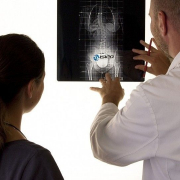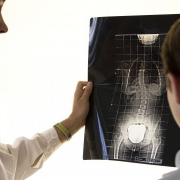Bracing works better in Italy
Bracing treatment reduces the risk of needing surgery, but the proportion of patients who manage to avoid the scalpel differs between Europe and North America. The factor that makes the difference is patient compliance, i.e. a patient’s adherence to, and belief in, the course of bracing treatment prescribed. In this regard, Italian patients certainly come out on top.
This is what emerged from a study conducted by ISICO entitled “AIS Bracing Success is Influenced by Time in Brace: Comparative Effectiveness Analysis of BrAIST and ISICO Cohorts”, which has just been published in the scientific journal Spine.
The study was based on a comparison of two populations of patients at high risk of surgery, which showed that, after bracing treatment, 39% of US patients go on to have surgery, as opposed to just 12% of patients treated by ISICO. The Italian institute sent clinical data referring to patients seen by its specialists to the University of Iowa, so that these data might be compared with those obtained in previous research published by the American group in 2014.
“We worked in collaboration with the researchers at the University of Iowa” explains Dr Sabrina Donzelli, ISICO physician and author of the paper. “In 2014, our American colleagues published a randomized controlled multicentre trial called the “Bracing in Adolescent Idiopathic Scoliosis Trial (BrAIST)”. The resulting paper, by Lori Dolan and Stuart Weinstein, was published in the New England Journal of Medicine. Their study, the most important on this topic in the past 30 years, involved 383 patients from 25 US and Canadian institutes studied between March 2007 and February 2011. It showed that brace treatment reduced the percentage of patients requiring surgery. Given that surgeons and families in North America have always had a rather negative attitude towards bracing (unlike those in Europe, where it is well received), the authors were surprised by this finding. We took the results of the BrAIST study as the starting point for our research, comparing them with our own data. Working with our American colleagues, we selected patient subpopulations comparable for disease severity and risk of surgery”.
This comparison was a demanding task requiring clarity: the Italian researchers and the American surgeons from the Children’s Hospital of Iowa measured the radiographs of the patients from the BrAIST study and of 169 patients being treated at ISICO, in order to objectively verify the data.
What did the comparison show? That bracing treatment at Isico works better, with the proportion of at-risk Italian patients who actually had surgery found to be just a third of the proportion recorded in the American population (12% vs 39%). It also emerged that the ISICO patients, respecting the treatment prescribed, wore their brace for a far greater number of hours than their American counterparts.
“Patient compliance is crucial,” Dr Donzelli continues “Our patients are careful to respect their doctor’s prescriptions, and the doctors and patients enjoy a good relationship based on mutual trust and faith in the proposed treatment. All this adds up to great teamwork between the patient, his/her family, the doctor, the orthopaedic technician and the physiotherapist”.










